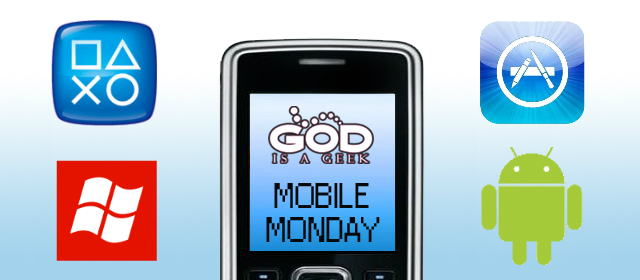You know what day it is? It’s Monday again and that can mean only one thing here at GodisaGeek: It’s time for another edition of Mobile Monday, the article where we take a look at four mobile games and let you know if they’re worth your time and money.
This week we’re taking a look at four Nintendo eShop/3DS games; The Legend of the River King from Natsume, HarmoKnight from Nintendo, Code of Princess from Agatsuma Entertainment/Bones and Nano Assault EX from Shin’en Multimedia.
Read on to find the full reviews of each game, but don’t forget to come back next week for more Mobile Monday reviews. While you’re here, if you have played any of the games listed, or even just want to come back once you’ve had a go to let us know how you got on, we’d love to hear from you in the comment box at the bottom of the page.
![]() LEGEND OF THE RIVER KING by Mick Fraser:
LEGEND OF THE RIVER KING by Mick Fraser:
I have to confess that, not being the type of gamer who hankers after all things retro, it was a good hour after starting Legend of the River King that I realised why it all seemed so familiar. It’s because, long, long ago, I spent many hours in the corner of my room with a GameBoy Colour, playing the living hell out of it.
Obviously time and technology has rendered such charming little games merely bygone classics, and the majority of modern gamers – those whose gaming choices aren’t made through rose-tinted nostalgia-goggles – will miss such forgotten gems and may never understand the idling joy of simple yet challenging tasks that don’t involve popping heads, eviscerating zombies or exploding small Eastern Bloc countries to rescue leather-clad femmes.
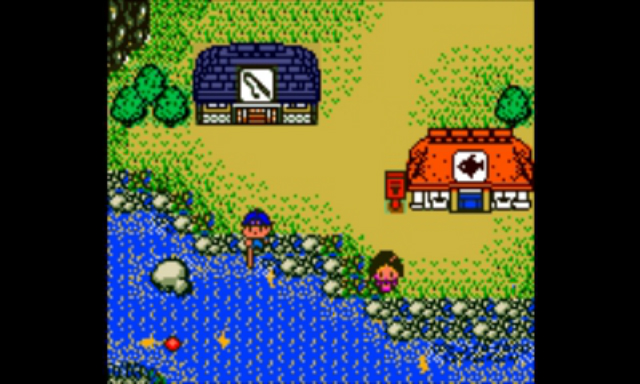
Legend of the River King is a simple game – though by that I don’t mean “easy”. Rather, the premise is uncluttered and the mechanics are uncomplicated – it’s basically a low-maintenance fishing sim with RPG elements. You play a young boy whose sister has been struck down with an illness that can only be cured by the oil of a special fish, known as the Guardian. Taking up rod instead of sword and bait, lures and tools instead of spells, bows and healing potions, you head out to the river determined to hunt down the legendary trout.
The fishing itself is fairly straightforward. You move to the river’s edge, then press ‘A’ to bring up your fishing menu. From here you can use certain types of bait or activate special lures; any fish you catch can be traded in for cash, which in turn buys bigger and better tools – which in turn hook you more expensive fish. Once you have the bob in the water and surrounded by fish, it’s a case of waiting until you get a bite. At this point the camera view will switch to an underwater angle, and you use ‘A’ to pull against the struggling fish and ‘B’ to reel it in. Landing the scaly old beggars is a case of knowing which button to press when, as these fish are rarely pushovers. It’s easy to go hungry until you’ve gotten the hang of it.
The cutesy isometric world is reminiscent of any number of games from the era, from early Legend of Zelda to Pokemon, and will evoke a strong sense of nostalgia in gamers of a certain age or bent. Obviously it’s unfair to judge the graphics against modern titles, but it’s suffice to say that Legend of the River King was, and still is, a colourful, charming game. It won’t last you very long (anywhere between three and five hours will probably see you done, depending on your skill level), but you do have the option to play on and keep fishing until you’ve found all of the species of fish the game has to offer.
Legend of the River King is a cute little aside that may not be able to compete on a real level with many of today’s games, but doesn’t really have to. You’ll buy this for the idling, time-wasting joy it provides on a lazy afternoon and, like a great many Virtual Console games available for the 3DS, the sentimental value. Definitely one worth reeling in.

![]() HARMOKNIGHT by Lee Garbutt:
HARMOKNIGHT by Lee Garbutt:
While developers Game Freak might be best known for developing the massively successful Pokemon games, in the rare occasions they have strayed from monster battling, they have proved that they are a studio that excel in extremely fun games (example: The GBA’s Drill Dozer). HarmoKnight is yet another charming and simple game from The House of Pikachu.
Part Rhythm game, part Endless Runner, HarmoKnight requires the player to jump or attack at particular times to beat every level and save the world from the Noizoids, a race of evil beasties that threaten the peace in the land of Melodia. Most levels consist of running through a level, jumping at the correct time to collect musical notes, and attacking enemies that are in your way. As you progress you’ll meet companions on your travels, and occasionally mid-level the game switches control to these friendly folk, who control in slightly different ways to the hero, Tempo.
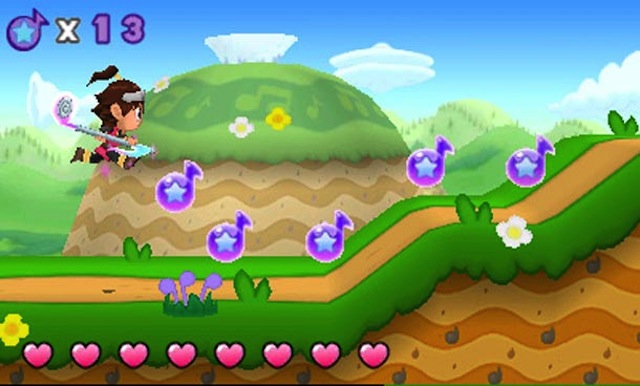
Adopting a cheerful, colourful cartoon aesthetic, HarmoKnight is quintessential Nintendo fun. While the game rarely penalises you for failing (except in a very rare occasion when you fall down a bottomless pit), it does occasionally require you to be very accurate with your timing but, like Nintendo’s Rhythm Heaven/Paradise/Tengoku series, it is pure addictive fun. It’s also quite the looker in three dimensions, with clean and clear 3D visuals with occasional changes in viewpoint that really look good with that 3D slider turned up, as well as 2D cutscenes that convey the game’s (admittedly quite childish) story.
It’s good fun for kids (and big kids) of all ages, and with plenty of levels (including several Pokemon-themed secret levels) there is plenty to see and do here, with each world adopting a particular style of music. For those who find the game a bit too easy, there’s even an option to play Fast versions of each stage (once a Great grade is received on a level). Well worth checking out, and further evidence that Game Freak should take a break from Pokemon more often.

![]() CODE OF PRINCESS by James Bowden:
CODE OF PRINCESS by James Bowden:
You might have seen a piece of artwork from Code of Princess. It was probably of the lead female, Princess Solange Blanchefleur de Lux, who isn’t wearing much more than a flannel and some bacon fat. You might have instantly written the game off, shaking your head and uttering something along the lines of “them crazy Japanese artists!” Thing is – if you hadn’t already guessed from that ridiculous name – Code of Princess doesn’t take itself seriously. At all.
A necromancer puppet made of deceased body parts, a guitar-twiddling elf that owes money to a cat dressed in Egyptian garb and a tomboy thief join the painfully do-goody Princess Solange as the four playable characters in the story mode of this Guardian Heroes-like brawler. A story mode that contains bickering villains, jiggling furballs and a nun who is “particularly good at exorcisms”. There’s enough silly here to offset any attempts to justify Solange’s questionable dress, and it’s all delivered through delightfully on-note voice acting. Every voice actor seems in on the joke; even the villagers sound good.
The gameplay is utterly bonkers to boot, given time. Guardian Heroes has been mentioned and not without good cause – Code of Princess was created by some shared talent (character designer Tetsuhiko Kikuchi and lead programmer Masaki Ukyo) and features a very similar style of combat that involves moving between three “planes” while beating up a colourful cast of baddies, levelling up your character’s attributes between stages. It’s not as refined as Treasure’s Saturn classic, most notably due to its twitchy framerate (a framerate that, when viewed in 3D, can sometimes render code of Princess unplayable) and because it takes a little levelling up before things really start to flow.
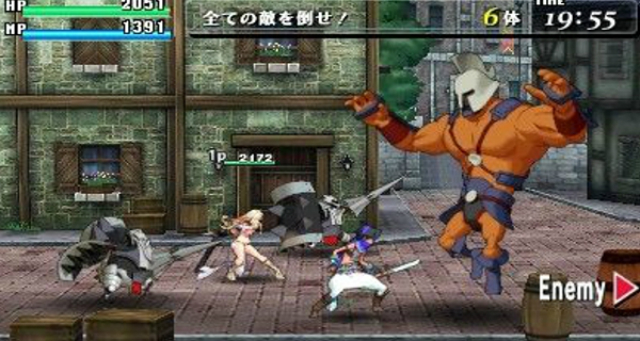
Give it the time it needs and Code of Princess grows into something very enjoyable. Through extended play, and through a better handle on the controls, even the framerate stutters become amusing. You’ll rarely take damage due to them and they tend to accompany your huge explosions of power and damage, making them – like Solange’s armour – more comical than they first appear.
So what of the price then? At twenty five pounds this isn’t the usual sort of cheap tat you find us investigating in Mobile Monday, but then Code of Princess came concealed in a box over in America. A box with a CD. It was lovely. Unsurprisingly then, this is a game with retail-quality bulk. The solid campaign can be played with four players while Free Play and the rock hard Bonus Missions can be attempted with a diverse cast of eight. You’re looking at tens of hours to beat all that, playing solo or in local/online co-op. The whole package is rounded off with a four man versus mode that lets you play as any character in the entire game. Even the barmaid from the cutscene before level 5 is selectable. Barmy.
So, you might have seen the price of Code of Princess. You might have instantly written the game off, shaking your head and uttering something along the lines of “Them crazy NoE price chaps!” Thing is – if you hadn’t already guessed from this horribly cliché call back – Code of Princess is actually pretty good, given half a chance.

![]() NANO ASSAULT EX by Sean Smith:
NANO ASSAULT EX by Sean Smith:
They may not sound very Teutonic, but Shin’en are a developer hailing from Munich, who cut their teeth producing a C64-influenced, Western-style shooter for the Gameboy Advance, but who now helm a shmup series of their own so widely regarded that it even gets published in Japan. Did you get all that? Stay with us here.
That well-regarded shooty concern was the Nano series of games, which I first experienced a staggering eight years ago, using a primitive chunky Nintendo DS – you know, the ones you had to power using a wind-up handle. Nanostray was a corker – not something you can often say when it comes to shooters made in this part of the world. A sequel provided more nice-looking scrolling thrills a few years later. DS owners weren’t exactly spoiled for choice in the shooter department either, with only Bangai-o Spirits and Ketsui Death Label to turn to in their hour of need. Shin’en were delivering in spades.
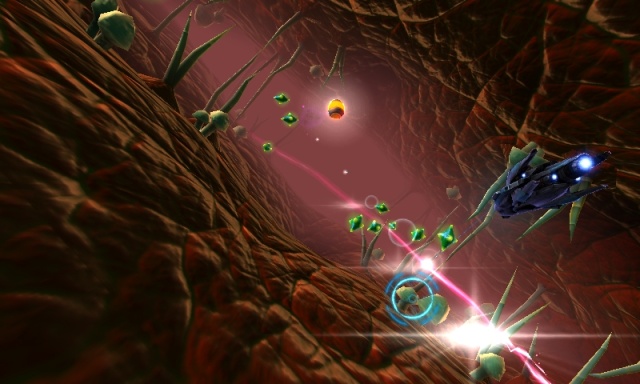
Nano Assault was the logical, 3DS sequel, which married the time-honoured Nano gameplay, silly sci-fi plot (think Inner Space but in the future, actually in space) to the dazzling stereoscopic trickery of the console. It worked, offering a 3D, twin stick (well, one stick and the face buttons) lovely looking title which was favourably reviewed upon its retail release. I have lost count of the number of craptastic Western shoot’em ups I have played over the years. Last Hope springs to mind – that much heralded (and also German-made) Neo Geo/Dreamcast dud. Nano Assault was the complete antithesis – rather than trying to ape the Japanese style, they created something that is very much their own work, whilst still appealing to nerds like me who have grown up playing shooters in arcades. The Wii U version was ace, as our review points out. Now, after some tweaking, we have the “EX”edition, but what exactly does that mean?
Nano Assault EX is a graphically-enhanced, downloadable eShop version of that game. And it is even more excellent. Gameplay wise, it is another in the long line of banging twin-stick shooters. Right up there with Geometry Wars and the Super Stardust titles, you pilot your tiny spacecraft against a horrific catalogue of virus-based enemies, attempting to prevent the impending destruction of civilization. You get all of the winning modes from the original, as well as the other cool stuff like the Nanopedia interactive bestiary thingy, thumping techno soundtrack and spot-on visuals that are amongst the upper echelon of 3DS aesthetics. There is the surprisingly in-depth story mode, a boss rush mode for Japanese shooter enthusiasts, and of course your standard Arcade mode. But EX brings a terrific new Survivor mode to the table – a desperate struggle to avoid death against the increasingly more turbulent set of odds – that really fits into the scheme of things well. There are also online leaderboards, meaning you can show off your score attack exploits against all of the internets. Not happy using the face buttons as directional controllers? Crucially, EX allows use of the Circle Pad Pro, which I would go as far as to say was essential to gain full enjoyment of this game. It is this last point that should help shift a few downloads of this winsome affair, as it works far better than the clunky original. Recommended.



